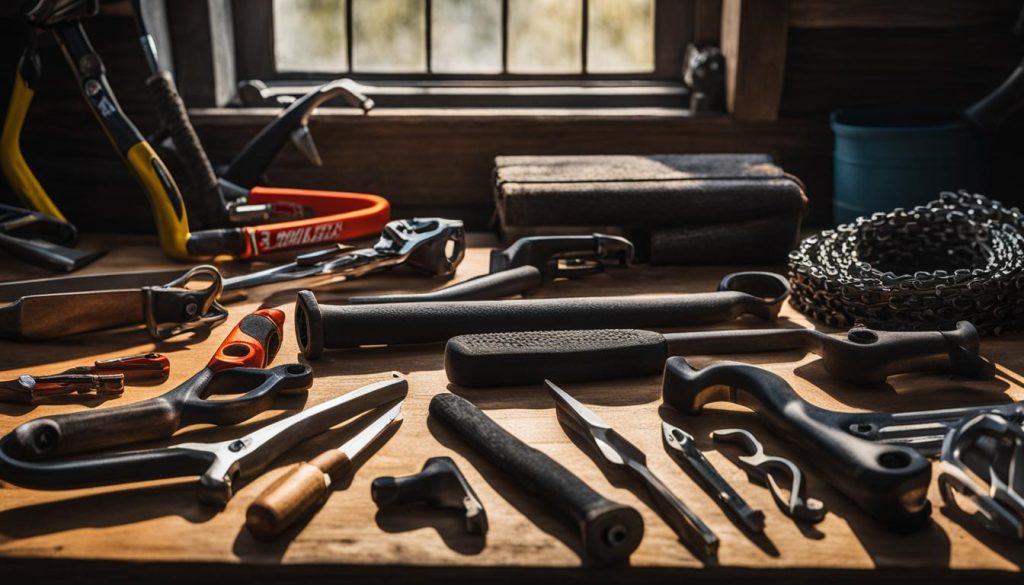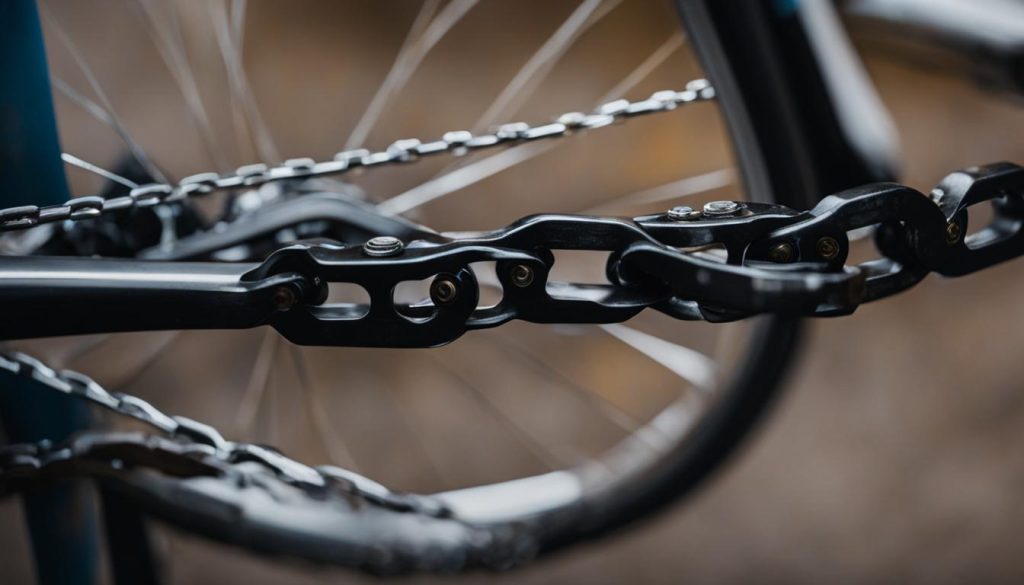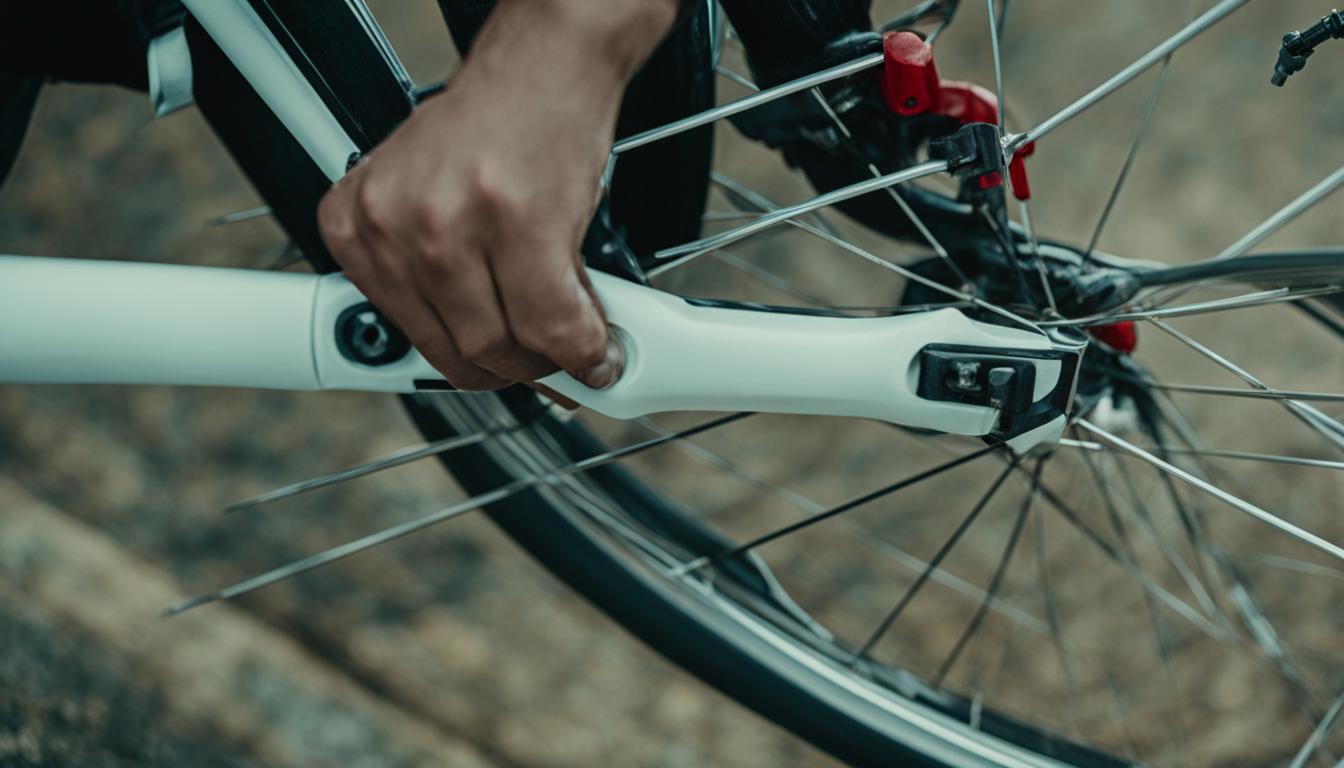One of the most overlooked aspects of cycling is the maintenance your bike requires to keep it in tip-top condition. Learning essential bike maintenance tips will help you understand how your bike works, perform basic adjustments and repairs, and know when components require servicing or replacing.
Read More : Discover America’s Best Mountain Bike Trails Today!
Regular care and attention can save you money in the long run and increase the lifetime of your bike. In this guide, we will provide beginner-friendly bicycle maintenance tips and tools you’ll need to keep your bike running smoothly.
Key Takeaways:
- Regular bicycle maintenance is essential for optimal performance and longevity.
- Invest in high-quality tools designed specifically for bike maintenance.
- Perform an M-check before each ride to identify any mechanical problems.
- Learn how to fix a puncture and carry the necessary tools for quick repairs.
- Check your tire pressure regularly to prevent issues and ensure optimal performance.
Essential Bike Maintenance Tools
When it comes to bike maintenance, having the right tools is essential. Whether you’re a beginner or a seasoned cyclist, investing in a good set of bike tools will make your maintenance tasks easier and more efficient. Here are some essential tools that every cyclist should have in their arsenal:
- Bike Tool Kits: A comprehensive bike tool kit is a must-have for any serious cyclist. These kits usually include a variety of tools such as hex keys, wrenches, tire levers, and more.
- Multi-tool: A multi-tool is a compact tool that combines various functions into one. It usually includes a range of hex keys, screwdrivers, and a chain breaker tool.
- Hex Keys: Hex keys, also known as Allen keys, are used to tighten or loosen bolts and screws on your bike. They come in different sizes and are essential for many maintenance tasks.
- Torque Wrench: A torque wrench is used to apply precise torque (tightening force) to bolts. It ensures that you don’t overtighten or undertighten bolts, which can lead to damage or failure.
- Bike Pump: A bike pump is essential for maintaining proper tire pressure. It comes in different types, such as floor pumps and mini pumps, and can be used to inflate both Presta and Schrader valves.
- Tyre Levers: Tyre levers are used to remove and install tires. They help you easily pry the tire off the rim without damaging the tube or the tire itself.
- Puncture Repair Kit: A puncture repair kit is a must-have for any cyclist. It includes patches, glue, and other tools needed to fix a flat tire on the go.
- Chain Breaker Tool: A chain breaker tool is used to remove and install bike chains. It’s essential for chain maintenance, such as replacing worn-out chains or repairing broken ones.
- Chain Checker: A chain checker tool is used to measure the wear of your bike chain. It helps you determine if your chain needs to be replaced to prevent damage to other drivetrain components.
- Shock Pump: If you have a bike with adjustable air forks or shocks, a shock pump is essential for maintaining proper suspension pressure. It allows you to fine-tune your suspension for a smooth and controlled ride.
Read More : How to Clean and Lubricate Your Bicycle
Having these essential bike maintenance tools will not only make your life easier but also save you time and money in the long run. With the right tools at your disposal, you’ll be able to handle basic repairs and adjustments with confidence, ensuring that your bike is always in top-notch condition.

Bike Maintenance Tasks for Beginners
As a beginner cyclist, there are several key bike maintenance tasks that you should learn to keep your bike in optimal condition. By performing these tasks regularly, you can ensure a smooth and enjoyable riding experience. Here are some essential bike maintenance tasks for beginners:
1. M-check
The M-check is a simple but effective routine to inspect your bike before every ride. It involves checking the main components of your bike, including the wheels, brakes, gears, and chain. By performing an M-check, you can identify any potential issues or malfunctions and address them before hitting the road.
2. Puncture Repair
Knowing how to fix a puncture is a crucial skill for every cyclist. Flat tires can happen unexpectedly, and being able to repair or replace a punctured tube can save you from being stranded. Make sure you have a puncture repair kit that includes tire levers, patches, and a pump. With a little practice, you’ll be able to fix a flat tire in no time.
“Learning how to fix a broken chain is a valuable skill that can keep you riding when unexpected breakdowns occur.”
3. Tire Pressure
Checking your tire pressure before each ride is essential for optimal performance and safety. Properly inflated tires provide better grip and reduce the risk of flats. Use a floor pump with a pressure gauge to ensure that your tires are inflated to the recommended PSI (pounds per square inch) according to the manufacturer’s guidelines.
4. Bike Cleaning
Regularly cleaning your bike, especially the drivetrain, is important for its longevity. Use a mild detergent and a soft brush or sponge to remove dirt and grime. Pay special attention to the chain, cassette, and derailleur. After cleaning, make sure to dry and lubricate the chain to prevent rust and ensure smooth shifting.
5. Brake Adjustment and Gear Indexing
Properly adjusted brakes and well-indexed gears are crucial for safe and efficient cycling. If your brakes feel spongy or your gears are not shifting smoothly, it’s time for some adjustments. Refer to your bike’s user manual or seek guidance from a bike maintenance class to learn how to adjust your brakes and index your gears correctly.
6. Chain Wear and Broken Chain
Regularly checking your chain for wear is important to prevent damage to other components. Over time, chains stretch and need to be replaced. Use a chain wear indicator tool to check the elongation of your chain. Additionally, knowing how to fix a broken chain can save you during unexpected breakdowns. Carry a chain breaker tool and learn how to use it effectively.
7. Bike Maintenance Class
If you want to enhance your bike maintenance skills further, consider attending a bike maintenance class. These classes provide valuable knowledge and guidance from experienced mechanics. You’ll learn advanced techniques, gain confidence in maintaining your bike, and have the opportunity to ask questions.

By incorporating these bike maintenance tasks into your routine, you can ensure the longevity and performance of your bike. Remember, regular maintenance and care will not only save you money on costly repairs but also provide you with a safer and more enjoyable riding experience. Happy cycling!
Conclusion
Proper bicycle maintenance is essential for keeping your bike in excellent condition and ensuring a safe and enjoyable riding experience. By following these beginner-friendly maintenance tips and using the right tools, you can perform basic adjustments, repairs, and inspections to keep your bike running smoothly.
Regular maintenance tasks such as checking tire pressure, cleaning your bike, and addressing common issues like flat tires and brake adjustments will prolong the lifespan of your bike and save you money on costly repairs.
Remember to prioritize safety and consult with a professional bike mechanic for more complex maintenance needs. With a little knowledge and practice, you can become confident in maintaining your bike and enjoying many miles of trouble-free riding. Take care of your bike, and it will take care of you.
FAQ
How often should I perform bike maintenance?
Regular maintenance is important for keeping your bike in good condition. It’s recommended to perform basic maintenance tasks, such as checking tyre pressure and cleaning your bike, before each ride. Additionally, you should perform a more thorough inspection and maintenance session every few weeks or as needed.
What should I do if I get a flat tire?
If you get a flat tire, you can repair it using a puncture repair kit. This typically involves removing the tire, locating the puncture, patching it, and then reassembling the tire. If you don’t feel confident in repairing the tire yourself, you can also replace it with a new one or seek assistance from a professional bike mechanic.
How do I check my tyre pressure?
To check your tyre pressure, you will need a bike pump with a pressure gauge. Simply attach the pump to the valve on your tire and pump until you reach the recommended pressure. The recommended pressure can usually be found on the sidewall of your tire. It’s important to check your tyre pressure before each ride to ensure optimal performance and prevent potential issues.
How often should I clean my bike?
Regular bike cleaning is important to prevent premature wear and corrosion. It’s recommended to clean your bike after muddy or wet rides and every few weeks as a general maintenance routine. Focus on cleaning the drivetrain, including the chain, cassette, and derailleur, as this area tends to accumulate the most dirt and grime.
How do I adjust my brakes and gears?
Adjusting your brakes and indexing your gears can greatly improve your bike’s performance. To adjust your brakes, you will need to loosen or tighten the brake calipers and ensure that the brake pads are aligned with the rim. Indexing your gears involves adjusting the tension on the gear cables to ensure smooth shifting. Detailed instructions and videos can be found online, or you can consult a professional bike mechanic for assistance.
How do I know when my chain needs to be replaced?
A chain checker tool can determine the wear of your chain. If the chain checker indicates significant wear, it’s recommended to replace the chain to prevent damage to other components, such as the cassette and chainrings. It’s important to regularly check your chain for wear, especially if you ride frequently or in challenging conditions.
How can I fix a broken chain?
Fixing a broken chain requires a chain breaker tool. This tool allows you to remove the damaged link and reattach the chain using a quick link or chain pin. It’s important to practice this skill before you encounter a broken chain during a ride. If you’re unsure, it’s best to seek assistance from a professional bike mechanic.
Should I attend a bike maintenance class?
Attending a bike maintenance class can be a valuable opportunity to learn hands-on skills and gain knowledge from experienced instructors. These classes can provide guidance on basic maintenance tasks, as well as more complex repairs. If you’re interested in enhancing your bike maintenance skills, attending a class can be a great investment.

